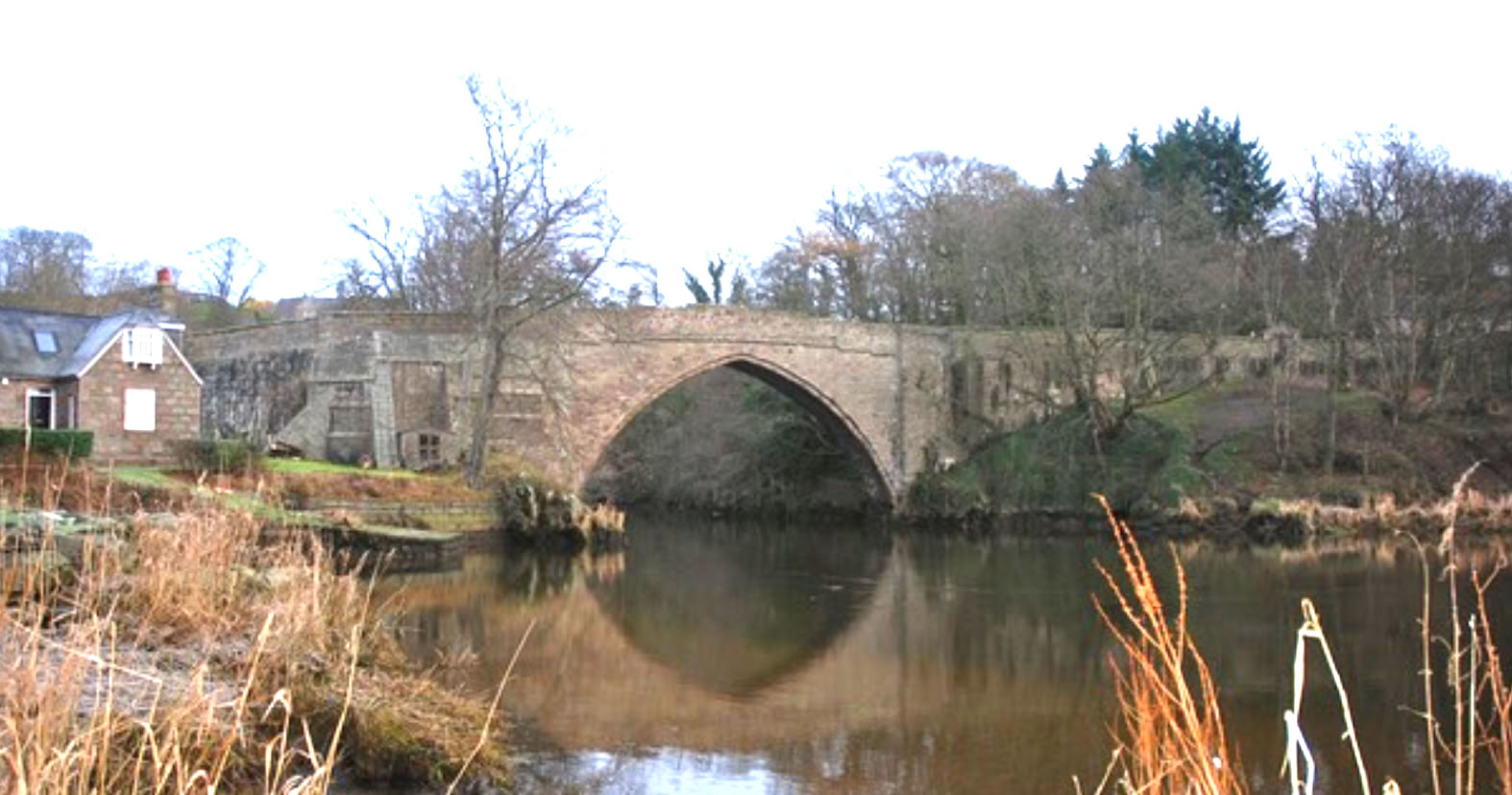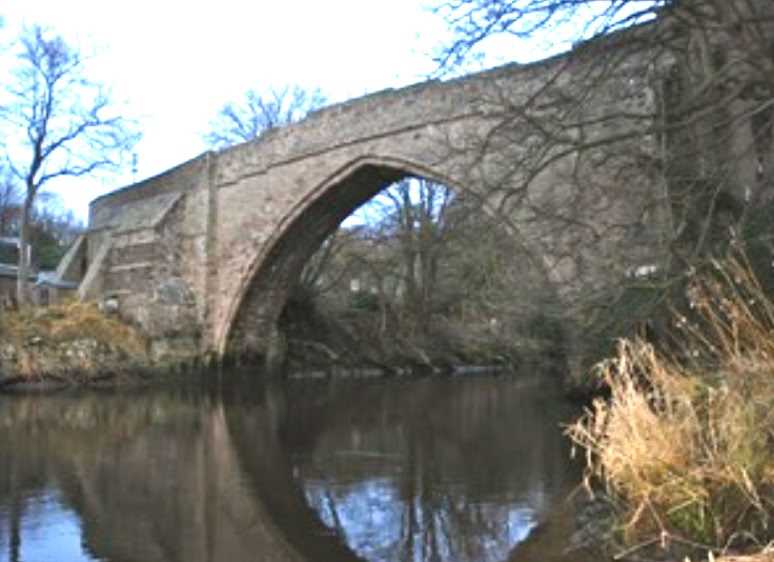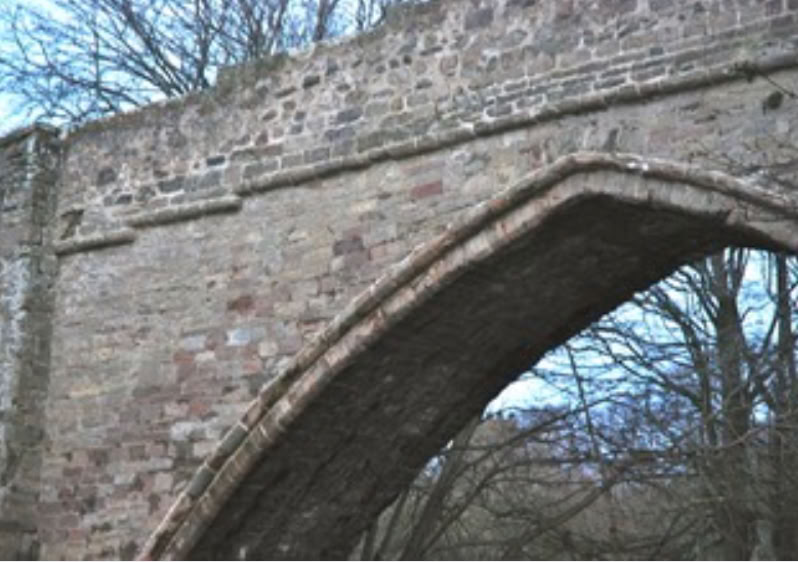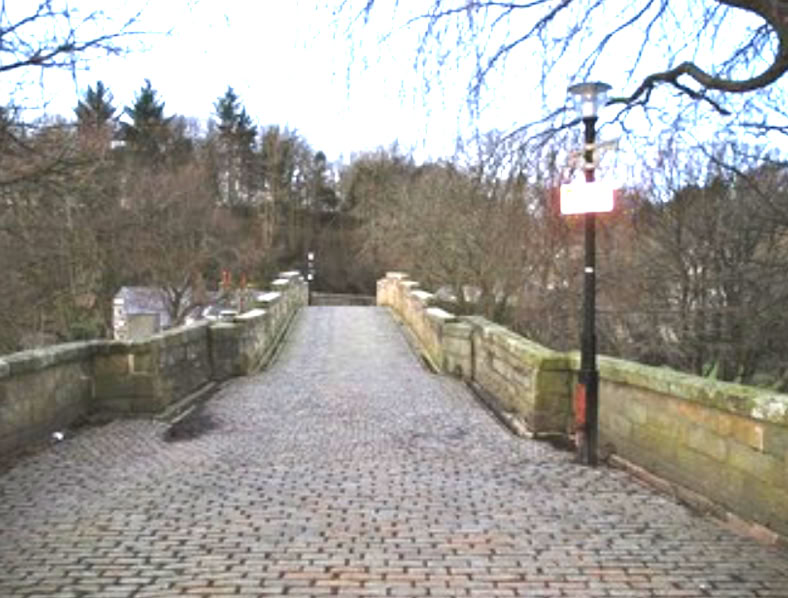Balgownie Bridge
The Brig o' Balgownie was known as the Bridge of Don until 1827 when it was bypassed downstream by a larger bridge. Before that, for about 500 years, the old bridge had been the only way north out of the city. The huge, single, elegant, 22-metre span Gothic arch rises to 12metres above the water with a gentle incline to the centre. The voussoirs and spandrels are in sandstone, but abutments, approaches and parapets are in granite, mainly ashlar but sometimes un-coursed, squared and random rubble, of later date. The deck is 3.2 metres wide. It has a rock foundation on either side with buttresses downstream and upstream on the approaches. There are slightly corbelled parapets with iron ties on top and a strong but very irregular protruding string course. A small bricked-up flood arch exists between parapets on the south approaches. A plaque built into a buttress at the west-end reads- “ANNO 1605 DOMINUS ALEXR HAV CLERICUS REGISTRI EX INNATO IN REMPUBLICAM AMORE 27 8 8 SCOTICOS EX QUIBUSDAM AGELLIS QUOTANNIS AD ABBREDONIAM HUIC FABRICAE SUSTENTANDAE DEDICAVIT”, a record that in 1605 Alexander Hay, for love of his country, dedicated £27 8s 8d Scots, to be paid yearly at Aberdeen, for maintenance. The panel's location implies a 17th century date for the buttress. A quaint ancient roadway descends to the north bank; this may have been the earliest approach road.
Balgownie is the oldest standing bridge in Scotland. It is reputed to have been built by Robert the Bruce (d.1329), or by Bishop Cheyne (d.1328), or by both of them contributing at different times. Richard Cementarius, King Alexander III's master mason, has also been proposed as the architect although he became Lord Provost of Aberdeen in 1272 which was before Robert I or Bishop Cheyne were born. Henri Cheyne (le Chen), who held the see of Aberdeen, was a strong supporter of John Balliol and of Edward I of England. The bishop conducted an extensive renovation of St.Machar's Cathedral (about 500m from the bridge), and although, for obvious reasons, he was no friend to Robert the Bruce it appears that they reconciled their differences. In 1322 Pope John XXII excommunicated Bishop Cheyne for his unapologetic support for the King. There was certainly room for collaboration between the two on any such project.
The first written history of Balgownie Bridge was by Alexander Hay, in 1605, who attributes its construction exclusively to King Robert on the foundation of a 1318 Act of Parliament titled: — "Carta restitutionis Iloberti liegis Henrico Episcopo Concessa" In fact, although this Act details much of the confrontation between the King and the Bishop, it does not mention the bridge at all. There was no substance to Hay's authoritative assertion about Balgownie, but that has not prevented its repetition through the centuries. Robert the Bruce was the author of many charters, some relating to Aberdeen, but none are linked to Balgownie. (Yet, there are certainly charters which link him to Perth Bridge and Bridge of Earn.) Overall, there appears to be no contemporaneous evidence for the bridge being built in the early 14th century, nor for any confirmation of the bridge’s sponsor. Macfarlane (Ref) presents a report, transcripted from Latin, dating from around 1590: "..it has one bow, but a very great one….the builder is unknown.” Around1665, Aberdeen's earliest mapmaker, Parson James Gordon, wrote “No man can certainly tell who builded the bridge of Done”. Today this seems to be a fair conclusion, but the implication from it all is clear: in the early 17th century the bridge was already regarded as extremely ancient.
There is a single charter reference to a bridge at Aberdeen in 1373. It is a Scone charter in the Parliamentary Records (Ref) , dating from the reign of Robert II, detailing a transaction in which a nominal rent must be offered annually ‘apud Abirdene, ad finem pontis’: at Aberdeen at the end of the bridge. Balgownie is the only realistic contender, because Dee Bridge had not yet been built, and the wording- ‘ at the end of the bridge’, suggests a large structure, firmly associated with the city. This seems to exclude any small town bridges and so appears to be the earliest reference to Balgownie. It is also to be the oldest reference to any complete, existing Scottish bridge.
Exchequer Rolls tell of major work done in 1444, by the Town Council, and again in 1453. In 1560, the Council used silver-plate for St. Nicholas Church to pay for further repairs. In 1587, it was predicted to ‘faill a short space gif timorously it be nocht bettit and repairit’. A toll was imposed. The bridge was comprehensively restored in 1605 thanks to the same Alexander Hay who had also brokered the Bridge of Don Fund, as noted on the buttress inscription. He raised the money by appealing to Government, churches and barons. The repairs cost £1128 (Scots) which seems to equate to £18,000 by RPI comparison. Compared to labour costs it is over £300,000, today. This sum is rather small and suggests a modest general repair rather than a comprehensive rebuild. Moreover, the absence of an invoice for wood implies that centering was not required; it is therefore unlikely that the arch was dismantled. Investment of remaining funds lasted 250 years and finally financed the construction of a second Don Bridge in 1827. In the floods of 1829, both bridges were threatened by the deluge. An enormous whirlpool developed at the old bridge. Both survived intact. There were further repairs to the old bridge in 1861, 1877, and 1912.
The bridge is certainly medieval bridge in style. However, it would have been a spectacularly innovative build in the late 13th or early 14th-century because of its size of span; this is enormous compared to Gothic arches of any period. In England, there are many 13th and 14th century pointed bridges of note, but only one has a span of that size, and it has a doubtful date from the 1380s. None of the English cathedrals have such large vault spans. However, there are some impressive arches from the period in Europe. The Puente del Diablo in Spain (1283) has a 37m. span, and the Ponte Vella (Galicia, 13th century) has an extraordinary span of 43m. So, it is not inconceivable that appropriate skills from Catalonia or Galicia were imported to Aberdeen in the 14th century. However, it would have been an impressive showpiece-construction meriting a lot of attention and one might have expected a mention of the build in English or Scottish documents. It is possible that such records were among those lost at sea in 1661 when the Eiizabeth of Burntisland sank off the Northumbrian coast (History Section).
Much of the above is conjecture, and perhaps it is only the charter reference from 1373 that permits us to affirm that Balgownie Bridge is the oldest surviving complete bridge in Scotland.




Page updated last in Sept.2020
Page last updated April ‘24